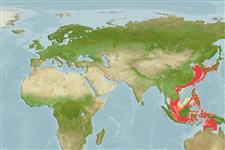Common names from other countries
>
Scombriformes (Mackerels) >
Scombridae (Mackerels, tunas, bonitos) > Scombrinae
Etymology: Scomberomorus: Latin, scomber = mackerel + Greek, moros = silly, stupid (Ref. 45335).
More on author: Lacepède.
Environment: milieu / climate zone / depth range / distribution range
Ecologia
marinhas; Água doce; estuarina; anfídromo; intervalo de profundidade 10 - ? m. Subtropical; 41°N - 14°S, 102°E - 140°E (Ref. 168)
Western Pacific: Akita, Honshu, Sea of Japan, Yellow Sea and China south to Vietnam and Cambodia where it enters the Mekong River.
Tamanho / Peso / Idade
Maturity: Lm ? range ? - ? cm
Max length : 247 cm TL macho/indeterminado; (Ref. 83530); common length : 100.0 cm TL macho/indeterminado; (Ref. 27773); peso máx. publicado: 131.00 g (Ref. 83530)
Espinhos dorsais (total): 15 - 17; Raios dorsais (total): 15-17; Espinhos anais 0; Raios anais : 16 - 19; Vértebras: 41 - 42. Interpelvic process small and bifid. Body covered with small scales. Lateral line abruptly curving down below first dorsal fin. Intestine with 2 folds and 3 limbs. Swim bladder present. Sides silvery with large round, indistinct spots in two poorly defined rows in adults. Juveniles with saddle-like blotches extending down to about middle of body.
Travels 300 km up the Mekong River, above Phnom Penh but believed to reproduce only in marine waters. Feeds on fishes and swims well upstream river because of easy food availability (Ref. 12693). No information on biology available (Ref. 9684). It is a prized food fish in Japan and probably in China as well. Utilized fresh, dried or salted and smoked; consumed pan-fried, broiled and baked (Ref. 9987).
Ciclo de vida ou comportamento de acasalamento
Maturidade | Reprodução | Desova | Ovos | Fecundidade | Larvas
Collette, B.B. and C.E. Nauen, 1983. FAO Species Catalogue. Vol. 2. Scombrids of the world. An annotated and illustrated catalogue of tunas, mackerels, bonitos and related species known to date. Rome: FAO. FAO Fish. Synop. 125(2):137 p. (Ref. 168)
Status na Lista Vermelha da UICN (Ref. 130435)
CITES (Ref. 128078)
Not Evaluated
Ameaça para os humanos
Harmless
Uso pelos humanos
Pescarias: espécies comerciais; peixe esportivo: sim
Mais informação
ReferênciasAquaculturaPerfil para aquaculturaEstirpesGenéticaElectrophoresesHereditariedadeDoençasProcessamentoConversão de massa
ColaboradoresFotosStamps, Coins Misc.SonsCiguateraVelocidadeTipo de nataçãoÁrea branquialOtólitosCérebrosVisão
Ferramentas
Relatórios especiais
Baixar XML
Fontes da internet
Estimates based on models
Preferred temperature (Ref.
115969): 11.9 - 28.3, mean 26.6 (based on 719 cells).
Índice de diversidade filogenética (Ref.
82804): PD
50 = 0.5000 [Uniqueness, from 0.5 = low to 2.0 = high].
Bayesian length-weight: a=0.00832 (0.00383 - 0.01808), b=3.03 (2.86 - 3.20), in cm Total Length, based on LWR estimates for this Genus-body shape (Ref.
93245).
Nível Trófico (Ref.
69278): 4.5 ±0.80 se; based on food items.
Resiliência (Ref.
120179): Baixo, tempo mínimo de duplicação da população 4,5 - 14 anos (Preliminary K or Fecundity.).
Fishing Vulnerability (Ref.
59153): Very high vulnerability (90 of 100).
